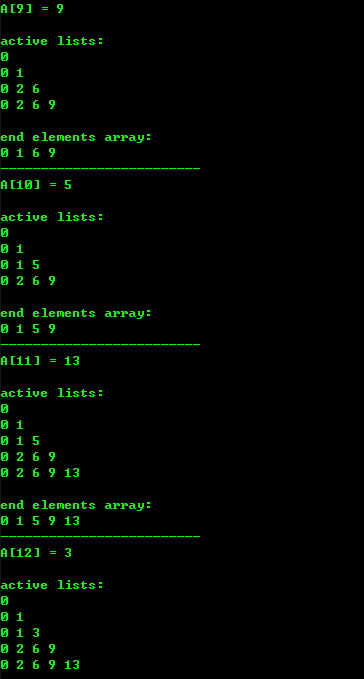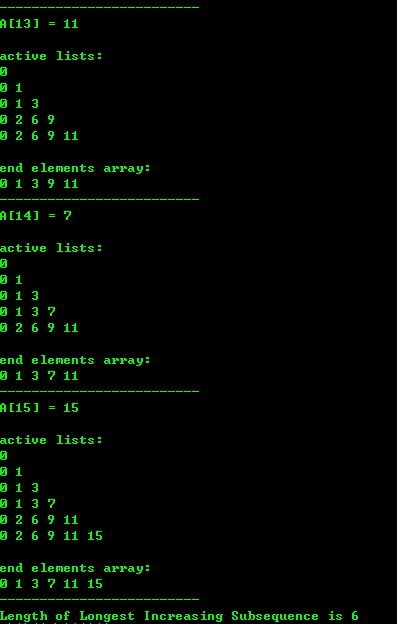Longest Increasing Subsequences(最长递增子序列)的两种DP实现
/**
@description: Longest Increasing Subsequence
@author: seiyagoo
@create: 2013.10.25
@modified: 2013.10.26
**/
int LIS_1(int A[], int size){ int *LIS = new int[size];
vector<int> *vec = new vector<int>[size]; /* Compute optimized LIS values in bottom up manner */
for(int i=; i < size; i++){
LIS[i]=; //初始化默认长度
int max_j=, flag=;
for(int j=; j < i; j++){ //查表,找出前面最长的序列, 若将A[i]加入LIS[j](LIS[j]+1的含义)的递增子序列比当前的LIS[i]更长, 则更新LIS[i]
if(A[i] > A[j] && LIS[i] < LIS[j]+){
LIS[i] = LIS[j]+;
max_j=j;
flag=;
}
}
if(flag) //copy前面最长子序列到vec[i]
vec[i].insert(vec[i].end(), vec[max_j].begin(), vec[max_j].end());
vec[i].push_back(A[i]); //最后放入A[i]
} /*Show LIS of the current state*/
vector<int>::iterator it;
cout<<left;
for(int i=; i<size; i++){
cout<<setw()<<A[i]<< " --> ";
for(it = vec[i].begin(); it!=vec[i].end(); it++)
cout<<*it<<" ";
cout<<endl;
} /* Pick maximum of all LIS values, namely max{LIS[i]} */
int max_len=;
for(int i = ; i < size; i++ )
if( max_len < LIS[i] )
max_len = LIS[i]; delete[] LIS;
delete[] vec; return max_len;
}
/**
@description: Longest Increasing Subsequence
@author: seiyagoo
@create: 2013.10.25
@modified: 2013.10.26
**/ // Binary search (note boundaries in the caller)
// A[] is ceilIndex in the caller
int CeilIndex(int A[], int l, int r, int key) {
int m; while( r - l > ) {
m = l + (r - l)/;
(A[m] >= key ? r : l) = m; // ternary expression returns an l-value
} return r;
} int LIS_2(int A[], int size) {
// boundary case: when array size is one
if( == size ) return ; int *tailTable = new int[size];
vector<int> *vec = new vector<int>[size];
int len; // always points empty slot //memset(tailTable, INT_MAX, sizeof(tailTable[0])*size); @bug for(int i = ; i < size; i++)
tailTable[i] = INT_MAX; tailTable[] = A[]; //tailTable[0] store the smallest value
vec[].push_back(A[]); len = ;
for( int i = ; i < size; i++ ) {
if( A[i] < tailTable[] ) { //case 1: new smallest value
tailTable[] = A[i]; /*discard and create*/
vec[].clear();
vec[].push_back(A[i]);
}
else if( A[i] > tailTable[len-] ) { //case 2: A[i] wants to extend largest subsequence
tailTable[len++] = A[i]; /*clone and extend*/
vec[len-] = vec[len-];
vec[len-].push_back(A[i]);
}
else { //case 3: A[i] wants to be current end candidate of an existing subsequence, It will replace ceil value in tailTable
int ceilIndex = CeilIndex(tailTable, -, len-, A[i]);
tailTable[ceilIndex] = A[i]; /*discard, clone and extend*/
vec[ceilIndex].clear();
vec[ceilIndex] = vec[ceilIndex-];
vec[ceilIndex].push_back(A[i]);
} /*Printf all the active lists*/
vector<int>::iterator it;
cout<<left;
cout<<"A["<<i<<"] = "<<A[i]<<endl<<endl;
cout<<"active lists:"<<endl;
for(int i=; i<len; i++){
for(it = vec[i].begin(); it!=vec[i].end(); it++)
cout<<*it<<" ";
cout<<endl;
} /*Printf end elements of all the active lists*/
cout<<endl<<"end elements array:"<<endl;
for(int i = ; i < size; i++)
if(tailTable[i] != INT_MAX)
cout<<tailTable[i]<<" ";
cout<<endl;
cout<<"-------------------------"<<endl;
} delete[] tailTable;
delete[] vec; return len;
}
五、运行结果
example:





Longest Increasing Subsequences(最长递增子序列)的两种DP实现的更多相关文章
- leetcode300. Longest Increasing Subsequence 最长递增子序列 、674. Longest Continuous Increasing Subsequence
Longest Increasing Subsequence 最长递增子序列 子序列不是数组中连续的数. dp表达的意思是以i结尾的最长子序列,而不是前i个数字的最长子序列. 初始化是dp所有的都为1 ...
- [LintCode] Longest Increasing Subsequence 最长递增子序列
Given a sequence of integers, find the longest increasing subsequence (LIS). You code should return ...
- [LeetCode] Longest Increasing Subsequence 最长递增子序列
Given an unsorted array of integers, find the length of longest increasing subsequence. For example, ...
- 673. Number of Longest Increasing Subsequence最长递增子序列的数量
[抄题]: Given an unsorted array of integers, find the number of longest increasing subsequence. Exampl ...
- [LeetCode] 300. Longest Increasing Subsequence 最长递增子序列
Given an unsorted array of integers, find the length of longest increasing subsequence. Example: Inp ...
- [leetcode]300. Longest Increasing Subsequence最长递增子序列
Given an unsorted array of integers, find the length of longest increasing subsequence. Example: Inp ...
- poj 2533 Longest Ordered Subsequence 最长递增子序列
作者:jostree 转载请注明出处 http://www.cnblogs.com/jostree/p/4098562.html 题目链接:poj 2533 Longest Ordered Subse ...
- [LeetCode] Number of Longest Increasing Subsequence 最长递增序列的个数
Given an unsorted array of integers, find the number of longest increasing subsequence. Example 1: I ...
- POJ 2533 - Longest Ordered Subsequence - [最长递增子序列长度][LIS问题]
题目链接:http://poj.org/problem?id=2533 Time Limit: 2000MS Memory Limit: 65536K Description A numeric se ...
- [LeetCode] 673. Number of Longest Increasing Subsequence 最长递增序列的个数
Given an unsorted array of integers, find the number of longest increasing subsequence. Example 1: I ...
随机推荐
- 【hihocoder 1122】二分图二•二分图最大匹配之匈牙利算法
[Link]:https://hihocoder.com/problemset/problem/1122 [Description] [Solution] 二分图匹配,匈牙利算法模板题; 这里我先把染 ...
- C++的class的样例
私有就是仅仅可以通过内部调用,在类外面是不可以使用私有成员的 简单的写一个 Class A { public: //你能够通过公有的函数去訪问私有成员 Demo() //能够在这使 ...
- Django加入JS,CSS,图片等外部文件的方法
Django加入JS,CSS.图片等外部文件的方法 By 白熊花田(http://blog.csdn.net/whiterbear) 转载需注明出处,谢谢. 在使用Django搭建站点时,往往须要使用 ...
- 9.Maven之(九)依赖关系
转自:https://yq.aliyun.com/ziliao/312160 在maven的管理体系中,各个项目组成了一个复杂的关系网,但是每个项目都是平等的,是个没有贵贱高低,众生平等的世界,全球每 ...
- 关于mybatis里面的Executor--转载
原文地址:http://blog.csdn.net/w_intercool/article/details/7893344 使用mybatis查寻数据,跟踪其执行流程 最开始执行的语句 this.ge ...
- Spring中事务的XML方式[声明方式]
事务管理: 管理事务,管理数据,数据完整性和一致性 事务[业务逻辑] : 由一系列的动作[查询书价格,更新库存,更新余额],组成一个单元[买书业务], 当我们动作当中有一个错了,全错~ ACID 原子 ...
- Direct2D 如何关闭抗锯齿
// Each pixel is rendered if its pixel center is contained by the geometry. // D2D1_ANTIALIAS_MODE_A ...
- 洛谷 P1679 神奇的四次方数
P1679 神奇的四次方数 题目描述 在你的帮助下,v神终于帮同学找到了最合适的大学,接下来就要通知同学了.在班级里负责联络网的是dm同学,于是v神便找到了dm同学,可dm同学正在忙于研究一道有趣的数 ...
- [RxJS] Learn How To Use RxJS 5.5 Beta 2
The main changes is about how you import rxjs opreators from now on. And introduce lettable opreator ...
- [React] Render Text Only Components in React 16
In this session we create a comment component to explore how to create components that only render t ...
